Ames W.F., Harrel E.M., Herod J.V. (editors). Differential Equations with Applications to Mathematical Physics
Подождите немного. Документ загружается.


This page intentionally left blank
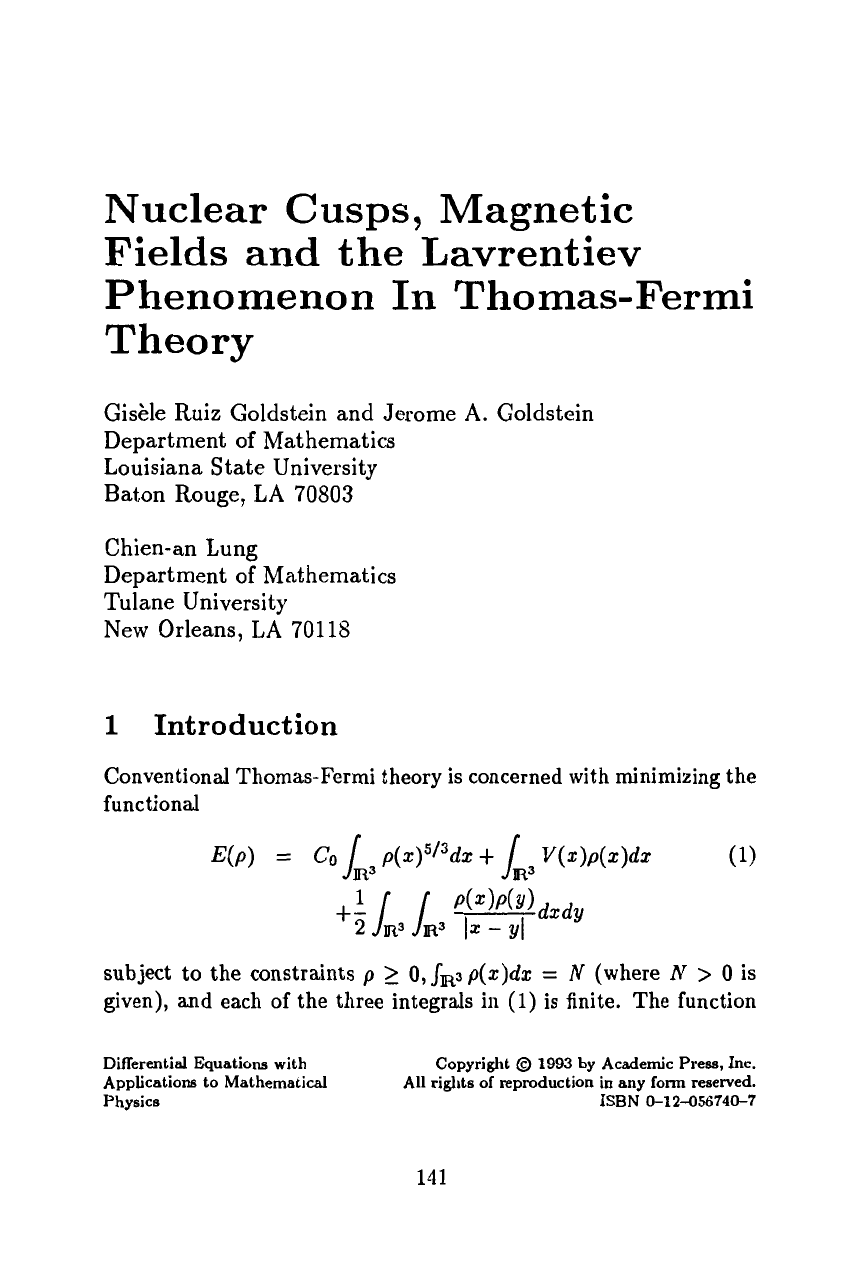
Nuclear
Cusps,
Magnetic
Fields
and the Lavrentiev
Phenomenon In Thomas-Fermi
Theory
Gisble Ruiz Goldstein and Jerome
A.
Goldstein
Department
of
Mathematics
Louisiana State University
Baton Rouge,
LA
70803
Chien-an Lung
Department
of
Mathematics
Tulane University
New Orleans,
LA
70118
1
Introduction
Conventional Thomas-Fermi theory is concerned with minimizing the
functional
subject
to
the
constraints
p
1
0,
J”3
p(z)dz
=
N
(where
N
>
0
is
given), and each
of
the three integrals in
(1)
is finite. The function
Dinerentid Equations with Copyright
@
1993
by
Academic
Press,
Inc.
Applications to Mathematical All riglits
of
reproduction in any
form
reserved.
Physics
ISBN
0-12-056740-7
141

142
G.
R.
Goldstein,
J.
A.
Goldstein and
C.
Lung
p
which minimizes
E
is the
ground state electron density
in Thomas-
Fermi theory corresponding to the potential
V.
More precisely, if
H
is the Hamiltonian of
a
quantum mechanical system of
N
electrons
under the influence of
a
potential
V,
then if
$J
is
a
normalized wave
function and
p
is its corresponding density, then
E(p)
is an approxi-
mation to the energy expectation value
(H$J,$)
(cf.
[13],
[6]).
Thus
minimizing
E(p)
gives an approximation to the ground state energy
and the density corresponding to the ground state wave function.
Ever since the original rigorous treatment of the minimization
problem for
E
by
E.
Lieb and
B.
Simon
[la],
[13], much attention
has focussed on various extensions. Of particular concern here is
the nuclear cusp condition, which we now prepare to describe. The
Euler-Lagrange equation for the convex functional
E
given by
(1)
is
(2)
5
3
Q
:=
-C0p2/3
+
Gp
+
V
+
X
=
0.
on the set where
{p
>
0)
and
Q
2
0
on
{p
=
O}.
Here
-X
is the
chemical potential, which
is
a
La.grange multiplier corresponding to
the constraint
JR3
p(z)d
5
=
N,
and
Gp(z)
:=
(-
1
*
p>(z)
=
IR
dy.
1.1
"-YI
Consider an atom,
so
that
I/(")
=
-Z/lxI
where
2
is the positive
charge of the nucleus, which is located at the origin. Since
for
z
close
to
zero a.nd (by Holder's inequality)
it follows that
Gp
+
X
is bounded near
2
=
0,
whence (see
(2))
p(.)
M
const121-3/2
(3)
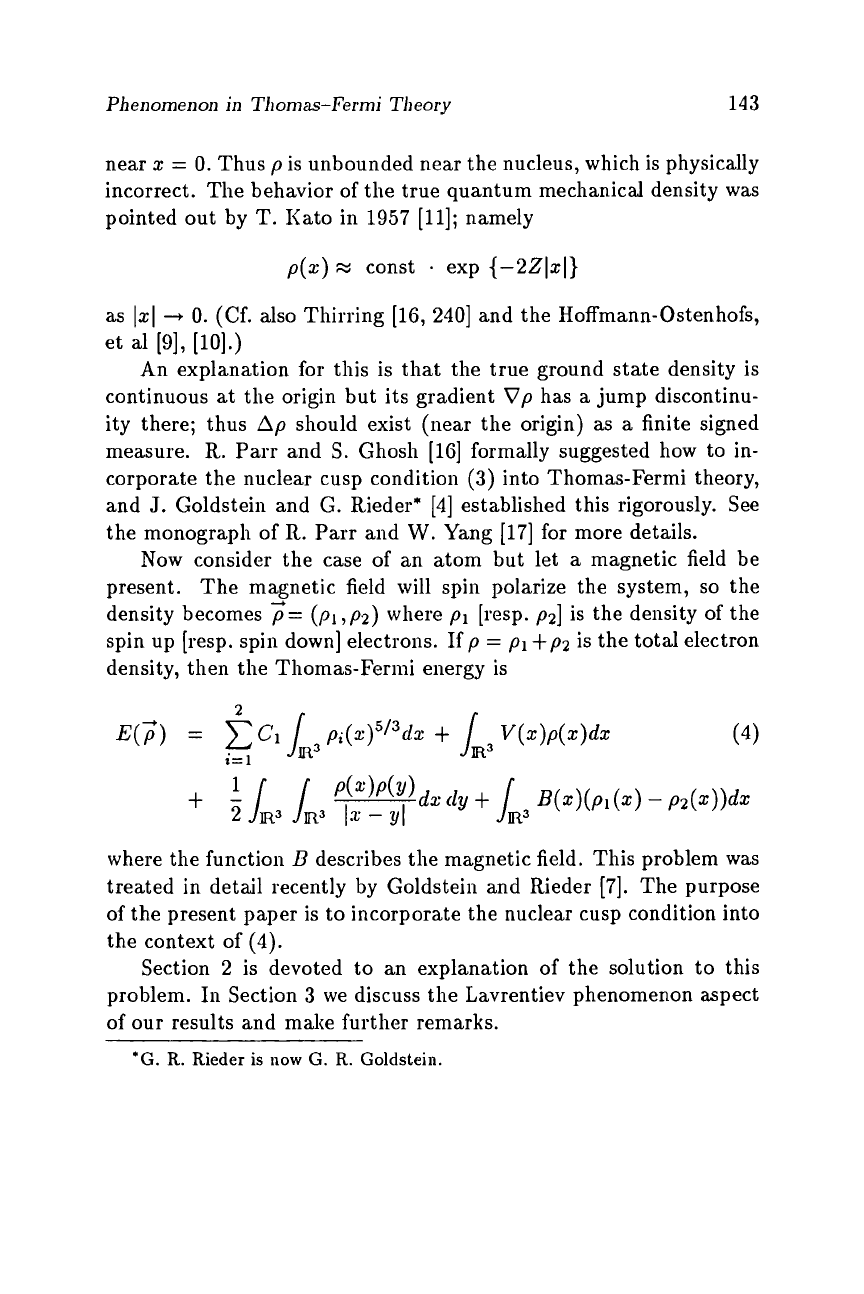
Phenomenon in
TI1
om
as-Fermi
Tfi
eory
143
near
z
=
0.
Thus
p
is unbounded near the nucleus, which is physically
incorrect. The behavior of the true quantum mechanical density was
pointed out by
T.
Kato in
1957
[ll];
namely
p(x)
x
const
-
exp (-221x1)
as
1x1
-+
0.
(Cf.
also Thirring
[lG,
2401
and the Hoffmann-Ostenhofs,
et
a1
[9],
[lo].)
An explanation for this is that the true ground state density
is
continuous
at
the origin but its gradient
Vp
has
a
jump discontinu-
ity there; thus
Ap
should exist (near the origin) as
a
finite signed
measure.
R.
Parr and
S.
Ghosh
[lG]
formally suggested how to in-
corporate the nuclear cusp condition
(3)
into Thomas-Fermi theory,
and
J.
Goldstein and
G.
Rieder*
[4]
established this rigorously. See
the monograph of R. Parr and
W.
Yang
[17]
for
more details.
Now consider the case of an atom but let
a
magnetic field be
present. The magnetic field will spin polarize the system,
so
the
density becomes
;=
(p1,p2)
where
p1
[resp.
p2]
is the density of the
spin up [resp. spin down] electrons. If
p
=
p1
+p2
is
the total electron
density, then the Thomas-Fermi energy is
where the function
B
describes the magnetic field. This problem was
treated in detail recently by Goldstein and Rieder
[7].
The purpose
of
the present paper is to incorporate the nuclear cusp condition into
the context of
(4).
Section
2
is devoted to an explanation
of
the solution to this
problem.
In
Section
3
we discuss the Lavrentiev phenomenon aspect
of our results and make further remarks.
‘G.
R. Rieder is
now
G.
R. Goldstein.
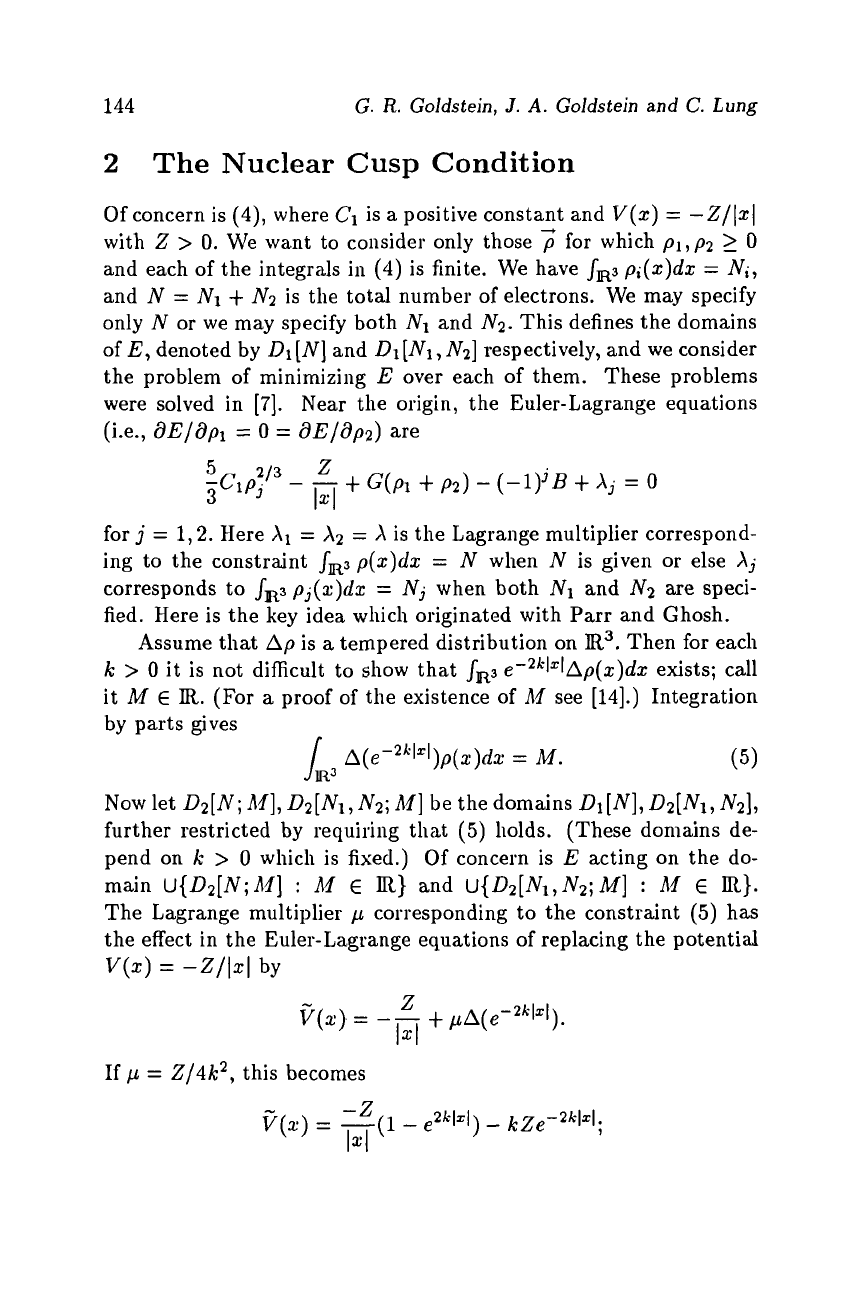
144
G.
R.
Goldstein,
J.
A.
Goldstein and
C.
Lung
2
The
Nuclear
Cusp
Condition
Of concern is
(4),
where
C1
is
a
positive constant and
V(z)
=
-Z/lxI
with Z
>
0.
We wa.nt to coiisider only those
for which
p1,p2
2
0
and each of the integrals in
(4)
is finite. We have
J&
p;(z)dz
=
Ni,
and
N
=
N1
+
N2
is the total number
of
electrons. We may specify
only
N
or we may specify both
N1
and
N2.
This defines the domains
of
E,
denoted by
D1[N]
and
D1[N1,
Nz]
respectively, and we consider
the problem of minimizing
E
over each
of
them. These problems
were solved in
[7].
Near the origin, the Euler-Lagrange equations
(i.e.,
aE/ap1
=
0
=
dE/dp2)
are
for
j
=
1,2.
Here
X1
=
X2
=
X
is the Lagrange multiplier correspond-
ing to the constraint
JR3p(z)dz
=
N
when
N
is given or else
Xj
corresponds to
Jn3
pj(z)dz
=
Nj
when both
N1
and
N2
are speci-
fied. Here is the key idea which originated with Parr and Ghosh.
Assume that
Ap
is
a
tempered distribution on
R3.
Then
for
each
k
>
0
it is not difficult to show that
JR3
e-2klzlAp(z)da:
exists; call
it
M
E
R.
(For
a
proof of the existence
of
A4
see
[14].)
Integration
by parts gives
Lt3
A(e-2klzl)p(z)dz
=
M.
(5)
Now let
D2[A';A4],D,[Nl,Nz;Ad]
be the domains
DI[N],D~[NI,N~],
further restricted by requiring that
(5)
holds. (These domains de-
pend on
k
>
0
which is fixed.)
Of
concern is
E
acting on the do-
main
U{D2[N;A4]
:
Ad
E
a}
and U{&[N1,Nz;M]
:
A4
€
a}.
The Lagrange multiplier
p
corresponding to the constraint
(5)
has
the effect in the Euler-Lagrange equations
of
replacing the potential
V(Z)
=
-Z/l~l
by
z
t(z)
=
--
+
pA(e-2klzl).
1x1
%(.)
=
-(1-
-2
If
p
=
Z/4k2,
this becomes
e2klEl)
-
kZe-2klzl;
I4
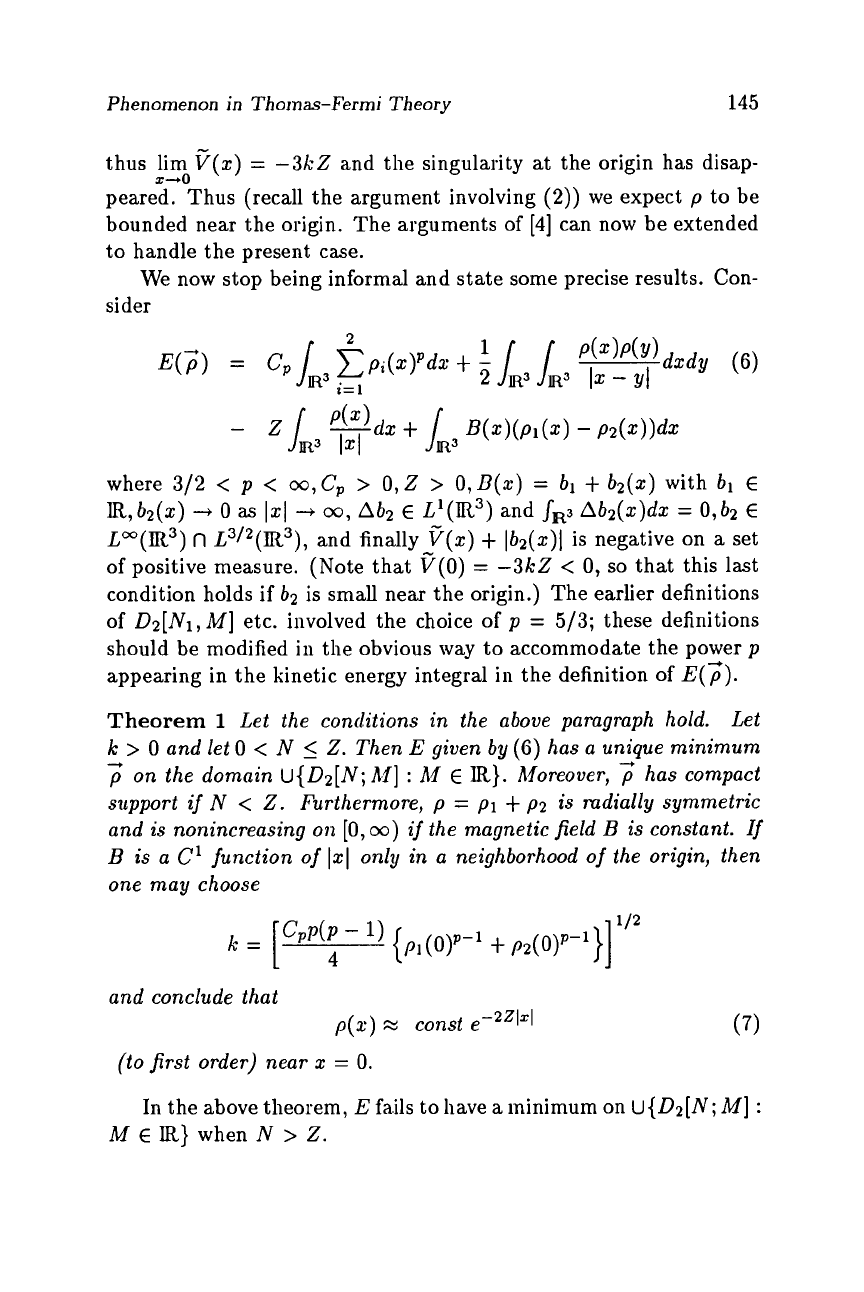
Phenomenon in Thornas-Fermi Theory
145
thus lim
v(z)
=
-3kZ
and the singularity at the origin has disap-
peared. Thus (recall the argument involving
(2))
we expect
p
to be
bounded near the origin. The arguments of
[4]
can now be extended
to handle the present case.
We now stop being informal and state some precise results. Con-
sider
x-+o
where
3/2
<
p
<
m,CP
>
0,Z
>
O,B(x)
=
bl
+
b2(2)
with
bl
E
IR,
b2(z)
-+
0
as
1x1
+
co,
Ab2
E
L'(IR3)
and JR3
Abz(s)dz
=
0,
b2
E
L"(IR3)
n
L3I2(IR3),
and finally
v(x)
+
lb2(z)1
is negative on
a
set
of positive measure. (Note that
F(0)
=
-3kZ
<
0,
so
that this last
condition holds
if
b2
is small near the origin.) The earlier definitions
of
Dz[Nl,M]
etc. involved the choice
of
p
=
5/3;
these definitions
should be modified in the obvious way to accommodate the power
p
appearing in the kinetic energy integral
in
the definition of E(Z).
Theorem
1
Let the conditions
in
the above paragraph hold. Let
k
>
0
and
let
0
<
N
5
2.
Then
E
given
by
(6)
has
a
unique
minimum
p
on the domain U{D2[N;
h,f]
:
h4
E
IR}.
Moreover,
3
has compact
support
if
N
<
2.
Furthermore,
p
=
p1
+
p2
is radially symmetric
and
is
nonincreasing
on
[O,co)
if
the magnetic field
B
is constant.
If
B
is
a
C'
function
of
1x1
only
in
a neighborhood
of
the origin, then
one
may
choose
-+
and
conclude that
p(x)
x
const e-2Zlrl
(7)
(to first order) near
x
=
0.
In the above theorem,
E
fa.ils to have
a
minimum on
U{D2[N;
M]
:
M
E
R}
when
N
>
2.
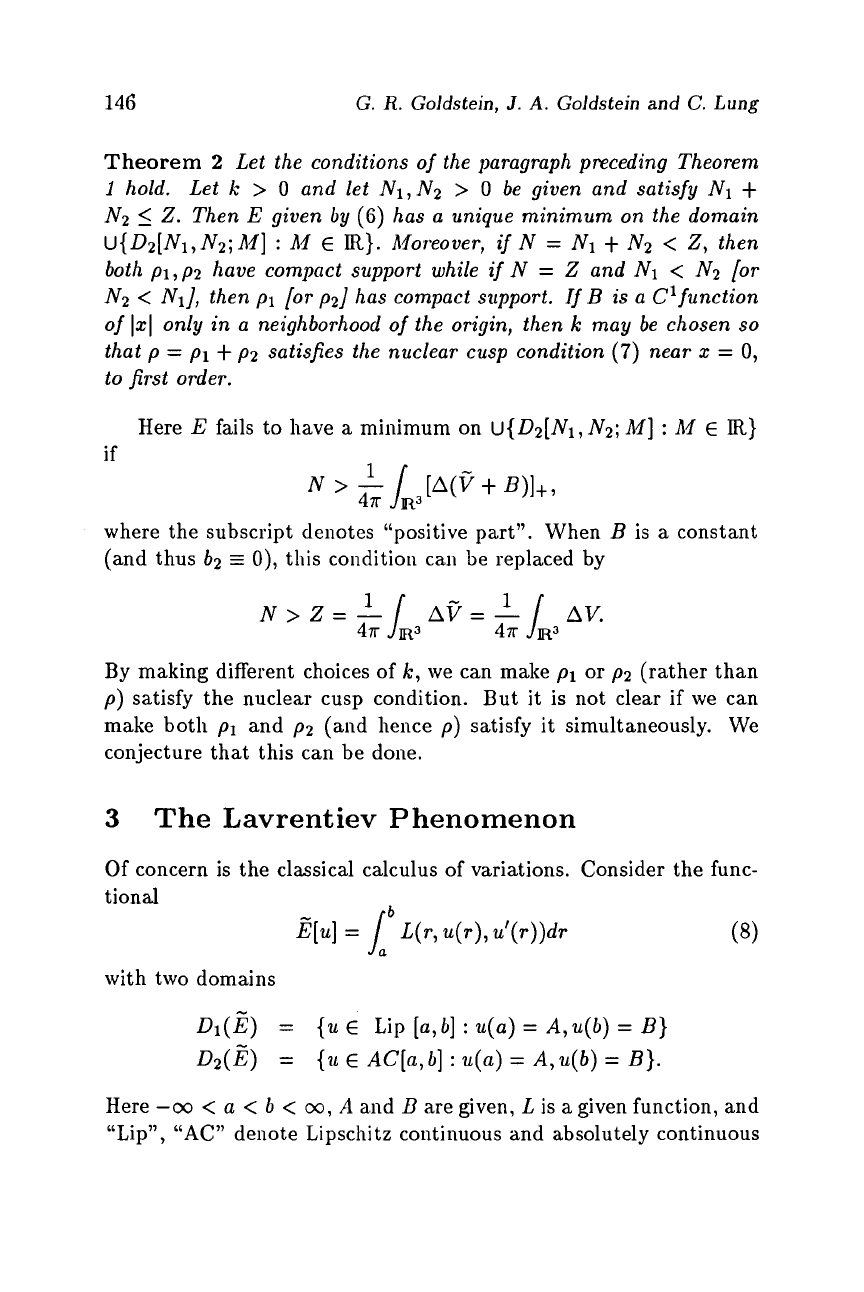
146
G.
R.
Goldstein,
J.
A.
Goldstein and
C.
Lung
Theorem
2
Let the conditions of the paragraph preceding Theorem
1
hold. Let
k
>
0
and
let
N1, N2
>
0
be given and satisfy
N1
+
N2
5
2.
Then
E
given
by
(6)
has
a
unique minimum on the domain
U{D~[NI,N~;A~]
:
A4
E
R}.
Moreover,
if
N
=
N1
+
N2
<
2,
then
both
p1,p2
have compact support while
if
N
=
Z
and
N1
<
N2
[or
N2
<
NI],
then
p1
[or
p2]
has compact support.
If
B
is
a C’function
of
1x1
only
in
a neighborhood
of
the origin, then
k
may be chosen
so
that
p
=
p1
+
p2
satisfies the nuclear cusp condition
(7)
near
x
=
0,
to first order.
Here
E
fails to have
a
minimum on
U{D2[N1, N2;
A41
:
A4
E
R}
if
where the subscript denotes “positive part”. When
B
is
a
constant
(and thus
b2
=
0),
this condition
can
be replaced by
AV=-
AV.
-
47r
‘J
IR3
By making different choices of
k,
we can make
p1
or
p2
(rather than
p)
satisfy the nuclear cusp condition.
But
it
is not clear if we can
make both
p1
and
p2
(and hence
p)
satisfy
it
simultaneously.
We
conjecture that this can be done.
3
The Lavrentiev Phenomenon
Of
concern is the classical calculus of variations. Consider the func-
tional
~[u]
=
J,”
L(r, u(r>, u’(r))dr
(8)
with two domains
Dl(,?)
=
D2(,?)
=
{u
E
Lip
[a,b]
:
u(u)
=
A,u(b)
=
B}
{u
E
AC[u,b]
:
.(a)
=
A,u(b)
=
B}.
Here
--oo
<
a
<
b
<
00,
A
aad
B
are given,
L
is agiven function, and
“Lip”, “AC” denote Lipschi tz continuous and absolutely continuous
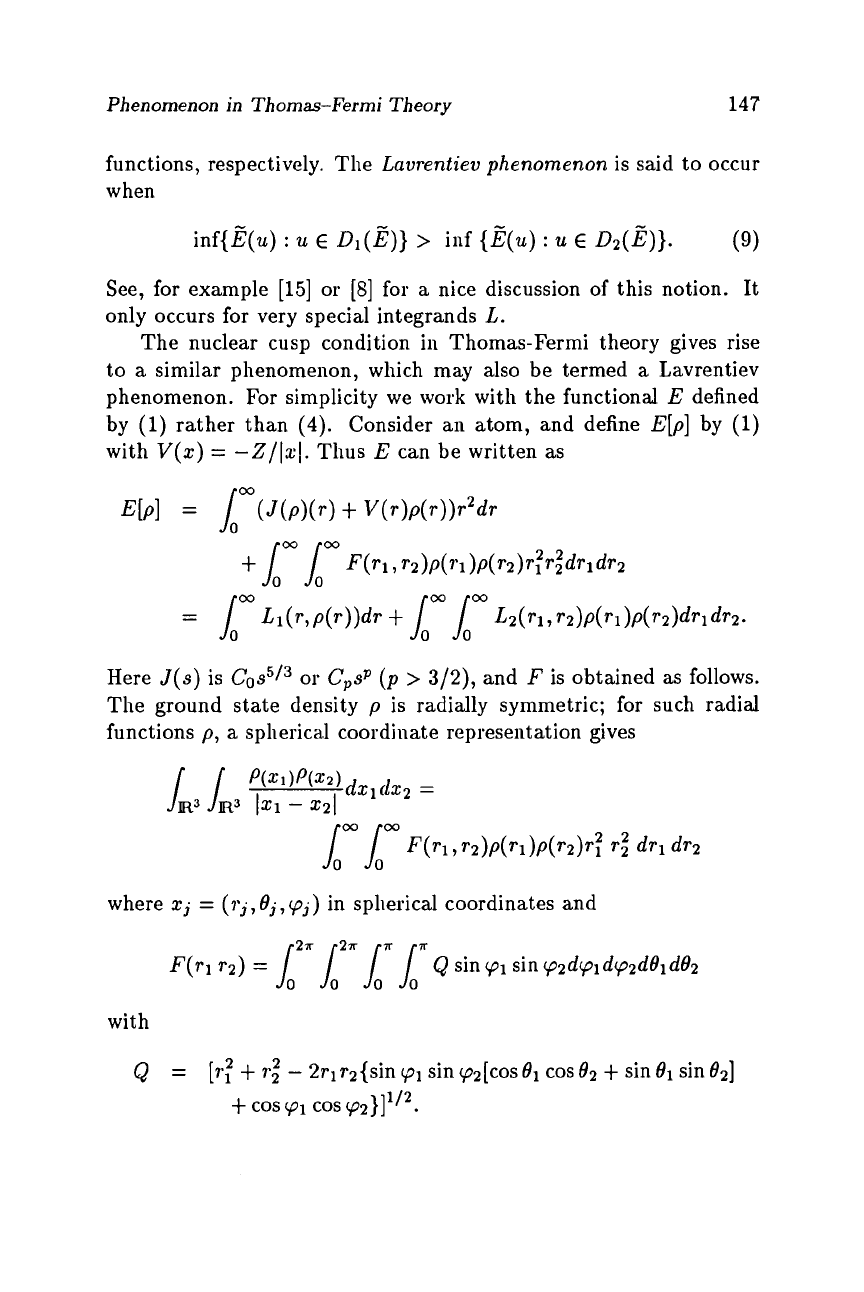
Phenomenon
in
Thomas-Fermi Theory
14T
functions, respectively. The
Lavrentiev
phenomenon
is said to occur
when
See, for example
[15]
or [S] for
a
nice discussion
of
this notion. It
only occurs for very special integrands
L.
The nuclear cusp condition in Thomas-Fermi theory gives rise
to
a
similar phenomenon, which may also be termed
a
Lavrentiev
phenomenon. For simplicity we
work
with the functional
E
defined
by
(1)
rather than
(4).
Consider
ail
atom, and define
E[p]
by
(1)
with
V(z)
=
-Z/lzI.
Thus
E
can be written as
Here
J(s)
is or
CPsP
(p
>
3/2), and
F
is obtained as follows.
The ground state density
p
is radially symmetric; for such radial
functions
p,
a
spherical coordinate representation gives
P(z1)Wz) dzlc~xz
=
JR3
In3
ixl
-
2'1
where
xj
=
(rj,Oj,vj)
in spherical coordinates and
with
Q
=
[r:
i-
1.22
-
2rlr2{sin
y1
sin
cp2[c0s
O1
cos 02
+
sin
O1
sin
021
+
cos
91
cos 'p2}]1/2.

148
G.
R.
Goldstein,
J.
A.
Goldstein and
C.
Lung
Let
U(T)
=
J:p(s)ds
and consider
u
as
a
basic variable rather than
p.
Thus
u'
=
p.
Define
E[u]
to be
E[p].
Then
E[u]
=
Lrn
Ll(T,
U'(T))dT
+
Lrn
Lrn
LZ(T1,
.Z).'(T1)~'(~Z)d~ld~Z.
(10)
This has two domains (at least), namely (given
N
>
0)
D1(E)
=
{u
E
Lip[O,oo]
:
u(0)
=
O,u(oo)
=
N,u
is nondecreasing,
Dz(E)
=
{u
E
AC[O,oo]
:
u(0)
=
O,u(oo)
=
N,u
is nondecreasing,
-
u'
E
L'(O,co),
and each integral in (10) exists}.
u'
E L'(O,oo), and each integral in
(10)
exists}.
Minimizing
3
over
Dz(E)
[resp. Dl(&)] with
N
5
2
gives the usual
Thomas-Fermi ground state (resp. the one satisfying the nuclear cusp
condition). We get
a
different ground state (namely
u'
=
p
is un-
bounded as
T
--+
0
in the Dl(E) case but is bounded as
r
+
0
in the
D2(E)
case). Thus (taking into account uniqueness)
(9)
holds.
In minimizing (8), when
L(T,U,U')
=
L(u,u')
is independent of
the
T
variable, the Lavrentiev phenomenon normally does not hold
[3].
This is not the case with
(10).
4
Remarks,
Open
Problems, and
Acknowledgements
In the case when one specifies both N1 and
Nz
it would be
of
inter-
est to show that both p1 and
p2
satisfy the nuclear cusp condition.
Also, in the case
of
a
constant magnetic field, BCnilan, Goldstein and
Rieder
[l],
[2]
found
a
critical point
of
the energy functional
E
given
by
a
modification of (4) incorporating the Fermi- Amaldi correction.
This allows one to find
3
whenever N1
+
NZ
5
2
+
1,
that is, singly
negative ions are allowed. It would be
of
interest to incorporate the
nuclear cusp condition into this context.
The results of this paper can be easily extended
from
atoms
to molecules. In this case
V(z)
=
-Z/lzI
is replaced by
V(z)
=
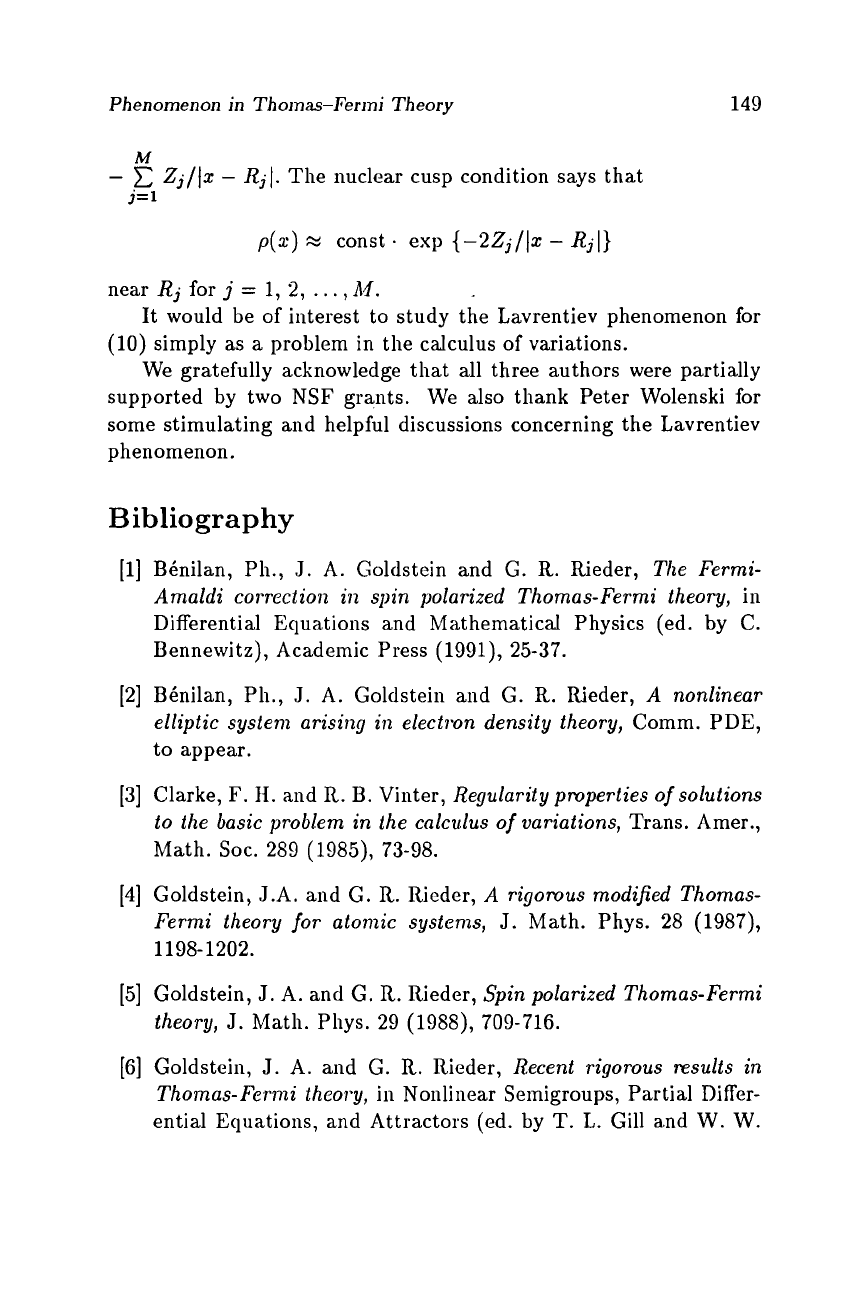
Phenomenon
in
Thornas-Fermi Theory
149
M
j=1
-
C
Zj/lx
-
Rjl. The nuclear cusp condition says that
p(2)
M
const
*
exp {-2Zj/la:
-
Rjl}
near
Rj
for
j
=
1,
2,
.
. .
,
A4.
It would be of interest to study the Lavrentiev phenomenon for
(lo)
simply
as a
problem in the calculus of variations.
We gratefully acknowledge that all three authors were partially
supported by two
NSF
grants. We also thank Peter Wolenski for
some stimulating and helpful discussions concerning the Lavrentiev
phenomenon.
Bibliography
[l]
BCnilan, Ph., J. A. Soldstein and G.
R.
Rieder,
The Fermi-
Amaldi correction in spin polarized Thomas-Fermi theory,
in
Differential Equa.tions and Mathematical Physics (ed. by C.
Bennewitz), Academic Press (1991), 25-37.
[2] Bhilan, Ph.,
J.
A.
Goldstein aiid
G.
R.
Rieder,
A
nonlinear
elliptic system arising in electron density theory,
Comm. PDE,
to
appear.
[3]
Clarke,
F.
H.
aiid
R.
B. Vinter,
Regularity properties of solutions
to the basic problem in the cnlcu.lus of variations,
Trans. Amer.,
Math. SOC. 289 (1985), 73-98.
[4] Goldstein, J.A. and
G.
R.
Rieder,
A rigorous modified Thomas-
Fermi theory for atomic systems,
J.
Math. Phys. 28 (1987),
1 1
98-
1
202.
[5]
Goldstein,
J.
A.
and
G.
R.
Rieder,
Spin
polarized Thomas-Fermi
theory,
J.
Math. Phys. 29
(198S),
709-716.
[6]
Goldstein,
J.
A. and G. R. Rieder,
Recent rigorous results
in
Thomas-Fermi theory,
in Nonlinear Semigroups, Partial
Differ-
ential Equations, and Attractors (ed. by
T.
L. Gill and
W.
W.
